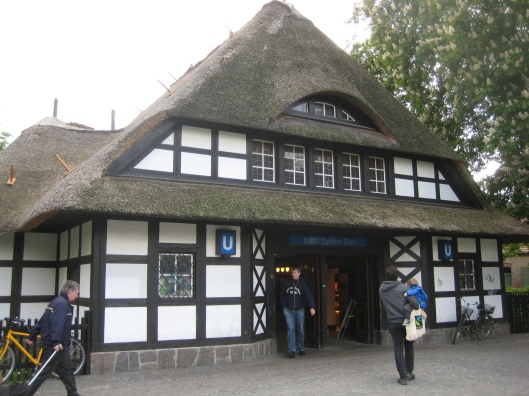The common reed (Phragmites australis) is a ubiquitous wetland grass of northern Germany whose tall golden stalks are currently quite noticeable in contrast to the surrounding green colors of spring. In urban landscapes around the world, reeds are used as a common form of biological treatment of wastewater which results in so-called constructed wetlands. Although this usage of Phragmites highlights a very modern utility of the plant aimed at dealing with increasing population densities in urban areas, common reeds possess a much older history intertwined with that of human settlement along the North and Baltic Seas.
Due to their natural abundance in northern Germany, Phragmites were traditionally used as a building material for thatched roofs. This kind of roof construction was widespread throughout Europe before the commercial availability of modern roofing materials. Yet, current demand for Phragmites in Germany still surpasses internal supply which means that a large portion of reeds used for thatched roofs has to be imported from Eastern Europe. In particular, the majority of imported reeds in Germany come from the Danube Delta in Romania, and questions have been raised regarding the sustainability of this practice in such a fragile ecosystem. Ironically, poor villagers in this isolated part of Romania cannot afford anything but Phragmites thatched roofs – in contrast to Germany where only the wealthiest are able to afford vacation homes with the status symbol thatched roofs.
Although Phragmites have a myriad other uses (for an interesting and informative ethnobotanical survey of the plant see here), what naturally interests the forager most is its edibility. The young shoots have a mild taste and can be eaten as vegetables, and the same goes for the roots that are tangled with the spring growth. These can be eaten raw or steamed, as preferred. Overnight, injured stems ooze out sweet syrup which can, according to our German plant book, be eaten as candy! Later in the fall, the seeds of the plant can be gathered and ground into flour or, for those who like to have fresh wild veggies in the winter, the seeds can be sprouted on your window sill.
The common reed is widespread in Berlin, and you are likely to find it along the shores of many lakes dotting the city. However, a lot of it grows in protected biotopes so care must be taken that only seeds are harvested from these places and the plants themselves remain unharmed. If you are interested in seeing a traditional German thatched roof, head to the Dahlem-Dorf U-bahnhof station, but don’t wait too long: Last week the roof caught on fire!




Excellent post; living beside large lakes with considerable, dense reed beds I’ve spent a lot of time over the years exploring them and the creatures they harbour. But this is the first time I’ve heard of eating them! Thanks for the tip, and for the tour of the common, yet beautiful, reed.
Thank you, Julian. We saw that a lot of your photographs have reeds in them… looks like a beautiful area! Let us know if you get a chance to try the shoots.
Thanks for stopping by my blog. It’s a lovely idea you have here- botany for the city dweller! We need a site like this in Montreal. 🙂
Thanks, Erin! glad you like it 🙂
As usual, an informative read…reed 😉 Phragmites is considered invasive in NE USA..replacing native cattails..Interesting to see another perspective..